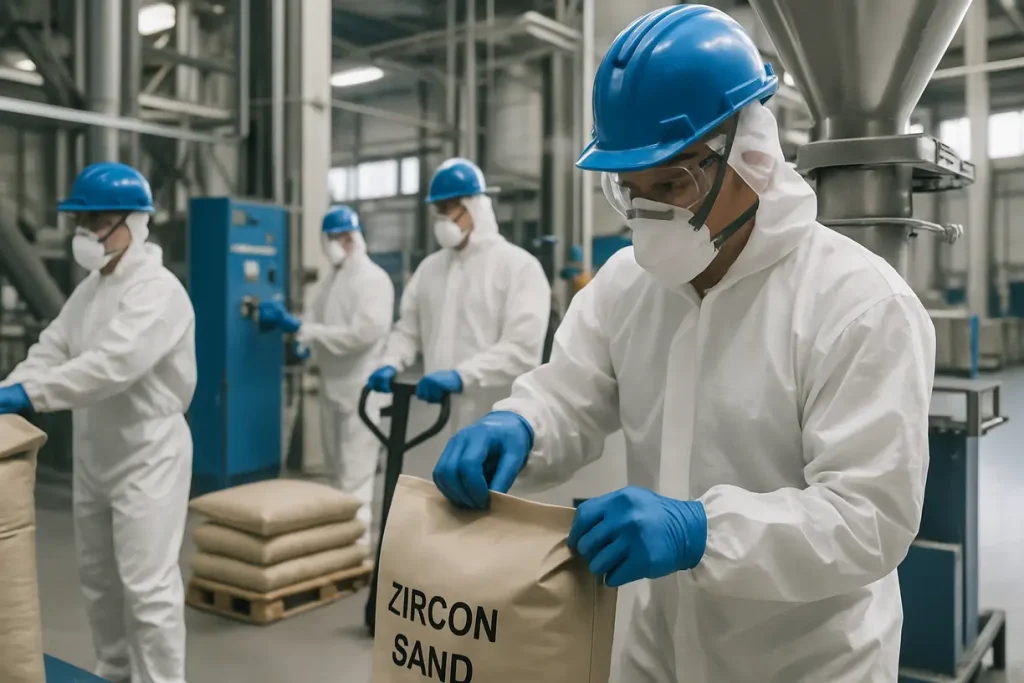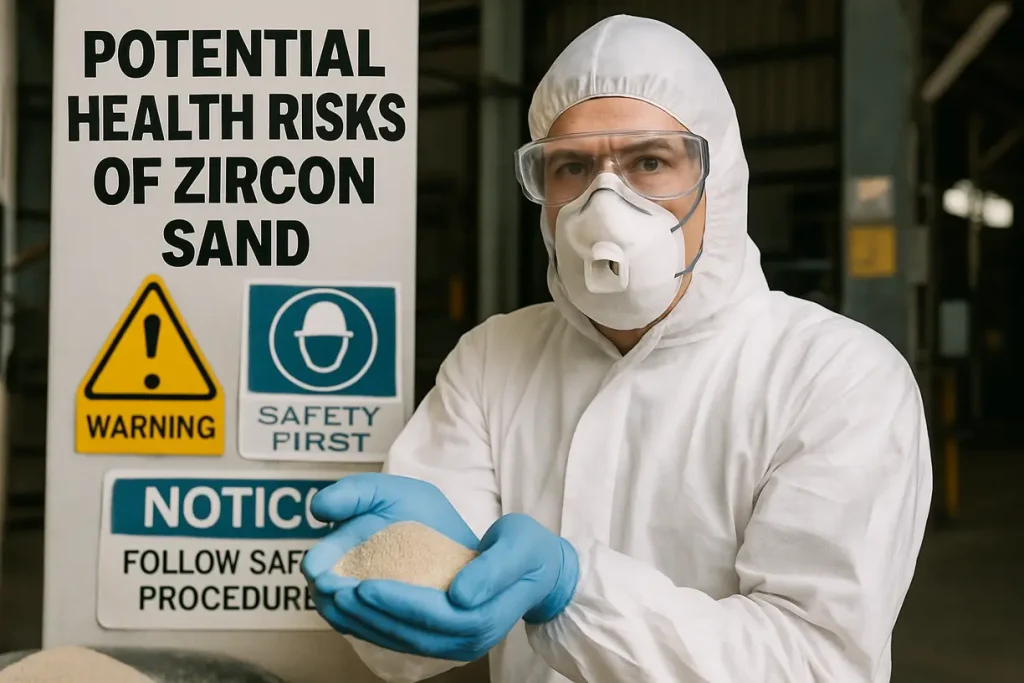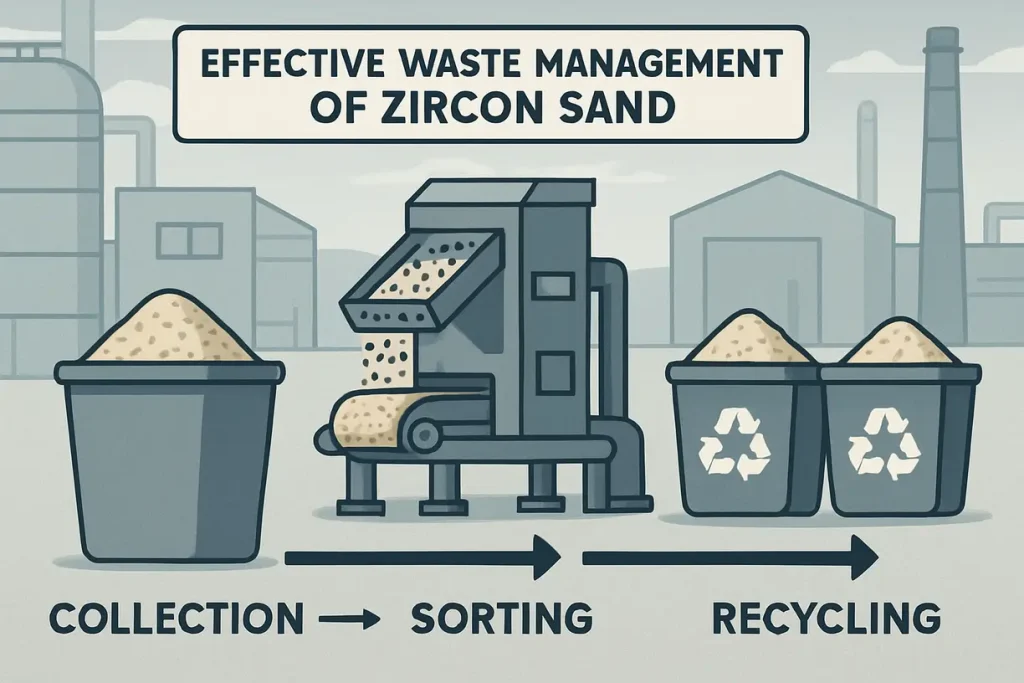Handling zircon sand in industrial settings poses various challenges, notably concerns regarding worker safety and environmental impact. For decision-makers like purchasing managers and safety officers, implementing effective safety protocols is paramount. These protocols not only safeguard employee well-being but also ensure regulatory compliance, ultimately leading to enhanced operational efficiency. This article provides actionable insights into developing and implementing safety protocols tailored specifically for handling this material. With a thorough understanding of best practices and regulatory requirements, you can create a safer work environment that protects workers and the organization.

This image depicts a team of workers in protective gear safely handling zircon sand in an industrial setting.
What Are Safety Protocols for Zircon Sand?
Safety protocols for handling zircon sand encompass a set of procedures designed to minimize risks associated with exposure and mishandling of this material. Zircon sand is widely used in industries like ceramics, foundries, and glass manufacturing. However, due to its fine particle nature, it poses health risks if inhaled or if it comes into contact with the skin, necessitating careful management and adherence to safety measures.
A comprehensive set of safety protocols should address several crucial components:
- Personal Protective Equipment (PPE): Workers must wear protective gear, including gloves, masks, and eye protection, to minimize exposure to harmful particles. This equipment is essential for safeguarding their health during operations.
- Standard Operating Procedures (SOPs): Detailed documentation of procedures is vital. These SOPs should outline the correct methods for safely handling zircon sand, from receipt and storage to processing and disposal.
- Training Programs: Regular training sessions are critical for educating employees about the potential hazards associated with zircon sand. This training ensures that workers are aware of safety practices and the importance of adhering to them.
By following these robust safety protocols, organizations can prevent accidents, enhance worker safety, and maintain regulatory compliance. Establishing a culture of safety not only protects employees but also demonstrates a commitment to their well-being and health, fostering a more efficient work environment.pliance. Adopting these measures not only promotes a culture of safety but also shows a commitment to employee health.
Why Is Proper Handling of Zircon Sand Critical?
Understanding the significance of proper handling of zircon sand is vital for several reasons. First and foremost, health risks arise from exposure to silica dust generated during handling. Workers who inhale this dust may experience respiratory issues like silicosis or chronic obstructive pulmonary disease (COPD), which can lead to long-term health complications that diminish their quality of life.
Moreover, zircon sand can also cause skin irritation upon contact, which makes adhering to safety protocols even more crucial.
Additionally, poorly managed materials can negatively impact the environment. Spills or leaks may introduce contaminants into soil or local waterways, affecting local ecosystems and wildlife. Regulatory bodies impose strict penalties on organizations that fail to adhere to environmental guidelines, making compliance not just a requirement but an ethical obligation.
Furthermore, the financial implications of improper handling cannot be disregarded. Companies may incur costs related to medical claims, regulatory fines, and damage to their business reputation if they fail to protect their employees and comply with regulations. Therefore, adopting stringent safety protocols mitigates these risks and is beneficial for both the workforce and the organization’s bottom line.
| Risks of Improper Handling | Consequences |
|---|---|
| Health Issues | Respiratory complications |
| Environmental Damage | Contamination of soil and water |
| Legal Liability | Fines and sanctions |

This image showcases a graphic of potential health risks associated with zircon sand exposure, emphasizing worker safety.
What Are the Key Components of Safety Protocols?
Safety protocols consist of several key components that create a robust framework for safe handling of zircon sand. Personal protective equipment (PPE) plays a critical role. Workers must wear appropriate gear, including gloves, respiratory masks, and goggles, to minimize exposure to harmful particles and reduce the risk of irritation or long-term health issues.
In addition to PPE, having clear standard operating procedures (SOPs) is crucial. These procedures outline the specific steps workers should follow when handling the material:
- Receiving the Material: Inspect for any visible signs of damage upon delivery, ensuring that the packaging is intact.
- Storing the Material: Store zircon sand in a designated area that minimizes dust generation. This can include sealing containers to prevent spills or using proper ventilation systems.
- Processing the Material: Employ best practices during processing, such as working in enclosed spaces or using dust extraction systems that help contain airborne particles.
Regular training and education of employees must not be overlooked. Safety training should be comprehensive, covering not just the hazards but also protocols for safe handling, emergency procedures, and personal health monitoring. Engaging workers through hands-on training sessions and simulations can enhance understanding and compliance.
Overall, a commitment to these key components creates a safer working environment and promotes a culture of responsibility among employees.
| Key Components | Description |
|---|---|
| Personal Protective Equipment | Gear like gloves and masks |
| Standard Operating Procedures | Detailed safety actions |
| Employee Training | Safety awareness and practices |
How Can You Develop Effective Safety Procedures?
Developing effective safety procedures calls for a systematic approach. Start by conducting a thorough assessment of workplace hazards associated with handling zircon sand. This assessment will help identify potential risks and inform the creation of tailored safety protocols.
Involve employees in the process. Their on-the-ground experience can provide valuable insights into where improvements are needed, making them feel more invested in safety measures. Engaging workers in discussions about safety fosters a culture of collaboration and accountability.
Once you identify risks and gather employee feedback, document the safety procedures clearly and comprehensively. Utilize straightforward language that is easy to understand, and ensure that employees can easily access this information. Additionally, consider using visual aids such as flowcharts or infographics to illustrate critical steps. Visuals often enhance comprehension and retention, making the protocols more effective.
Furthermore, it is essential to communicate these procedures consistently across the organization. Regular meetings and discussions can serve as checkpoints to review the protocols, address any concerns, and update employees on best practices. Establishing a feedback loop allows workers to voice their thoughts, leading to continuous improvement in safety measures.
By adopting these strategies, you can develop comprehensive safety procedures that empower employees and reinforce a commitment to handling materials safely.
| Steps to Develop Safety Procedures | Details |
|---|---|
| Assess Hazards | Identify risks in the workplace |
| Employee Involvement | Include workers in the development process |
| Clear Documentation | Use simple language for easy understanding |
What Role Does Equipment Maintenance Play?
Regular equipment maintenance is crucial in safeguarding against accidents during the handling of zircon sand. Equipment such as conveyors, hoppers, and dust collection systems must be maintained to ensure they function properly. Neglecting such maintenance can lead to failures that pose significant risks to operators and the surrounding environment.
To ensure optimal performance, implement a maintenance schedule that includes routine inspections, cleaning, and repairs. This proactive approach minimizes the likelihood of unexpected machinery breakdowns and enhances operational efficiency.
Consider incorporating the following routine checks:
- Lubrication: Regular lubrication of moving parts not only prevents wear and tear but also improves equipment lifespan.
- Visual Inspections: Check for damaged or worn components to identify potential issues before they escalate.
- Dust Collection Systems: Ensure that dust collection systems are functioning effectively to minimize airborne particles. This is especially vital as excessive dust can increase health risks for workers.
An investment in equipment with built-in safety features also enhances protection. Devices like emergency shut-off switches or safety guards can prevent injuries related to machinery malfunctioning. By prioritizing equipment maintenance, organizations create a safer work environment and ensure compliance with safety regulations.ed to machinery malfunctioning and act as an additional layer of safety for employees.
| Importance of Equipment Maintenance | Key Actions |
|---|---|
| Preventing Accidents | Regular inspections and repairs |
| Investment in Safety | Choose machines with safety features |
How Can You Create an Emergency Response Plan?
Creating an emergency response plan is a vital aspect of safety in handling zircon sand. This plan should outline the steps workers need to take during an emergency, such as a spill or equipment failure.
To create an effective plan:
- Identify Possible Emergencies: List scenarios specific to your workplace, such as chemical spills, equipment malfunctions, or fires involving zircon sand. Understanding these scenarios helps in tailoring the response plan appropriately.
- Define Roles and Responsibilities: Clearly outline each employee’s role when an emergency occurs, designating specific individuals as emergency coordinators. This ensures that everyone knows who to turn to for guidance during a crisis.
- Establish Communication Channels: Set up methods for notifying all personnel about an emergency, which may include alarms, intercom announcements, or mobile alerts. Make sure that contact numbers are easily accessible for quick communication.
- Develop Evacuation Routes: Clearly mark and communicate safe evacuation routes. Regularly review these routes to ensure they remain unobstructed and accessible.
Additionally, regular drills help ensure workers are prepared and familiar with the plan. These exercises serve as practical tests of the protocol, allowing employees to practice their responses and become more confident in their roles.
Keeping the emergency response plan updated is another essential factor. Changes in processes, equipment, or personnel must be reflected in the plan to ensure its effectiveness. This approach not only enhances worker safety but also boosts overall organizational readiness, ensuring that everyone is prepared to act decisively during an emergency.roach not only enhances worker safety but also boosts overall organizational readiness.
| Emergency Response Plan Components | Description |
|---|---|
| Defined Roles for Employees | Responsibilities during emergencies |
| Regular Drills | Practice and preparedness |
| Updates to Plan | Continuous improvement |
What Are the Best Practices for Disposal of Zircon Sand Waste?
DDisposing of zircon sand waste requires careful consideration and adherence to applicable regulations to minimize environmental impact. Organizations must follow established guidelines to prevent harmful effects on local ecosystems and comply with legal requirements.
Best practices include classifying the waste based on its hazardous levels. For instance, non-hazardous waste can typically be disposed of in regular landfill sites, while hazardous waste mandates specialized treatment.
To further improve your waste disposal processes, consider the following practices:
- Waste Segregation: Ensure that hazardous waste is separated from non-hazardous waste at its source to streamline disposal.
- Contact Environmental Specialists: Engage professionals familiar with local regulations to ensure compliance and proper disposal methods.
- Implement a Recycling Program: Innovative strategies for reclaiming and reusing zircon sand can significantly reduce the amount of waste generated. For example, companies can explore using recycled material in production processes.
Organizations that adopt these best practices not only fulfill their legal obligations but also demonstrate a commitment to sustainability. This approach can positively enhance public perception, build trust within the community, and potentially lower disposal costs over time.t also demonstrate a commitment to sustainability, which can enhance public perception and trust.

This image depicts effective waste disposal practices for zircon sand, highlighting segregation and recycling methods.
How Can You Ensure Compliance with Industry Standards?
Ensuring compliance with industry standards is non-negotiable for any organization handling zircon sand. Organizations should familiarize themselves with relevant regulations, including those set by OSHA and the EPA. Understanding these regulations is crucial, as non-compliance can lead to severe penalties, including fines and work stoppages.
Monitoring compliance continuously through internal audits and assessments can reveal weaknesses in safety measures. These audits should evaluate not only adherence to regulations but also the effectiveness of implemented safety protocols. Establishing a reporting mechanism that flags any non-compliance issues allows for quick corrective actions.
Additionally, fostering a culture of accountability among employees is essential. Encourage staff to speak up about safety concerns and compliance issues without fear of repercussions. This open communication can lead to quicker identification of potential problems.
Consider seeking outside expertise if needed. Consultants specializing in safety compliance can provide guidance and conduct audits to ensure that safety protocols meet relevant industry standards. Their objective perspective can help identify areas for improvement that internal teams may overlook.
Regular meetings dedicated to discussing compliance should be held. These meetings can reinforce the importance of maintaining compliance standards while updating everyone on the latest regulations. This investment pays off in maintaining a safe environment and avoiding potential fines.
| Compliance Strategies | Actions to Take |
|---|---|
| Familiarize with Regulations | Study OSHA and EPA guidelines |
| Continuous Monitoring | Conduct regular audits |
| Seek External Expertise | Hire safety compliance consultants |
What Resources Are Available for Improving Safety?
Many resources are available to organizations looking to improve safety in handling zircon sand. Industry organizations often publish best practice guides that are accessible online. These guides provide valuable insights based on the latest research and regulations, serving as important references for safety protocols.
Additionally, training modules—both online and in-person—can equip employees with the necessary knowledge about safe handling practices. Organizations may consider various types of resources, including:
- Webinars: Free sessions offered by industry organizations cover essential safety topics, allowing workers to learn from experts.
- Safety Manuals: Purchasing manuals tailored specifically for handling materials like zircon sand can offer in-depth guidance and best practices.
- Best Practices Conferences: Attending events where industry experts share insights fosters networking and keeps your team updated on the latest safety innovations.
Furthermore, utilizing online forums and communities dedicated to safety in industrial processes allows professionals to connect. Here, they can discuss challenges, share solutions, and learn from each other’s experiences. By tapping into these diverse resources, organizations can continuously improve their safety practices and create a culture of safety in handling materials effectively.s.
| Available Resources | Type |
|---|---|
| Industry Publications | Guides and manuals |
| Training Modules | Online and in-person |
| Networking Opportunities | Conferences and workshops |
How Can Technology Enhance Safety in Zircon Sand Handling?
Technology plays a pivotal role in enhancing safety during the handling of zircon sand. Innovations in safety equipment, such as automatic dust suppression systems, have been developed to combat airborne particles effectively. These systems work by using water sprays or misting techniques to capture dust before it becomes airborne, ensuring cleaner air in the workplace.
Additionally, software applications that continuously monitor equipment performance can alert management to potential issues, preventing accidents before they occur. For example, predictive maintenance tools analyze equipment data, including wear and tear, and can signal when machinery is likely to fail. This allows for timely repairs and reduces downtime.
Automation in handling processes can also significantly reduce the likelihood of human error associated with manual handling. Automated systems can manage the loading, transfer, and processing of zircon sand, minimizing direct contact with workers. This is particularly valuable in high-risk areas, where even minor mistakes can lead to serious consequences.
Integrating these technological advancements not only improves safety measures but can also lead to increased efficiency and productivity within the organization. As companies adopt these innovations, they will see a notable decrease in accidents and an overall enhancement of operational effectiveness.
| Technological Innovations | Examples and Benefits |
|---|---|
| Dust Suppression Systems | Reduce airborne particles |
| Monitoring Software | Predictive maintenance alerts |
| Automation | Minimizes manual handling risk |
Conclusion
In this article, we have delved into safety protocols for handling zircon sand in industrial settings. The key takeaway is that by implementing effective safety measures, you can significantly reduce health risks, meet regulatory requirements, and foster a culture of safety. From defining clear protocols to leveraging technology, these practices collectively ensure a safer environment.
Investing in these protocols not only benefits your employees but also positions your organization as a responsible leader in safety standards. For a comprehensive approach, contact Global Industry to receive tailored solutions that enhance safety in your operations. Together, we can build a safer workplace for all.
FAQ Section
Q1: What are the main health risks from zircon sand?
Zircon sand can generate fine dust particles that are hazardous when inhaled. Prolonged exposure may lead to respiratory issues such as silicosis and chronic obstructive pulmonary disease (COPD). Additionally, skin contact could cause irritation or allergic reactions.
Q2: What protective gear do workers need?
Workers handling zircon sand should wear appropriate personal protective equipment (PPE) like respirators to guard against inhalation, goggles to protect the eyes from dust, gloves to prevent skin contact, and coveralls for overall protection against exposure.
Q3: How often should safety procedures be reviewed?
Safety procedures should be reviewed at least once a year. However, they should also be updated immediately whenever there is a significant change in processes, regulations, or equipment, ensuring they remain effective against new and existing hazards.
Q4: Are there specific regulations governing zircon sand handling?
Yes, regulations such as those from the Occupational Safety and Health Administration (OSHA) and the Environmental Protection Agency (EPA) govern the handling of zircon sand. These regulations set standards for exposure limits, waste disposal, and environmental protections to ensure safety for both workers and the environment.
Q5: Where can I find additional resources on safety protocols?
Additional resources can be found through industry organizations that offer best practice guides, safety training courses, and workshops. Online platforms host webinars and forums where professionals share insights and experiences. Government agencies also provide resources for compliance and safety standards.
